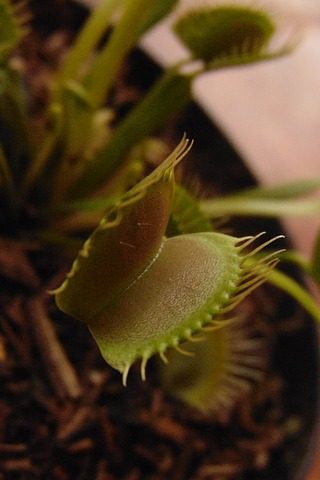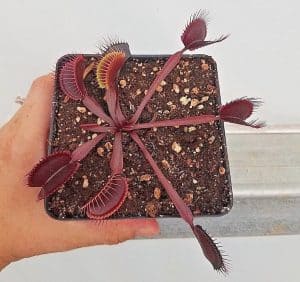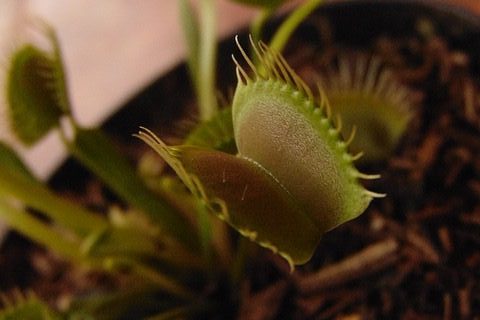Most people are familiar with the Venus flytrap. However, very few have heard about the B52 Venus Flytrap. Several different variations of Venus flytraps have been developed. The B52 Venus flytrap is a unique specimen. I have owned standard Venus flytraps and the B52 variety. Both kinds are beautiful, but the B52 can surprise the viewer due to its unique characteristics.
Standard Venus flytraps are small plants with adult traps of just 1 inch long. Over the years, botanists, scientists, and growers have developed different cultivars of this species. For example, they have bred the B52 Giant Venus flytrap.
Did you know you can buy B52 Venus flytraps commercially? Continue reading to find some reliable sources. Also, if you already own one or another type of Venus flytrap, I have included a Care Consideration section below.
The B-52 Giant Venus Flytrap Cultivars
The Venus flytrap or Dionaea muscipula is a specie original from the coastal areas of North Carolina and South Carolina. In the wild, Venus flytraps have lived for centuries in poor soil, and as a result, they have developed a prey trapping mechanism.
The Dionaea B52 is a Venus flytrap clone, which is considered a giant Venus flytrap. Dionaea B52 traps can reach the size of two inches, which is double the size of standard Venus flytraps.
The Dionaea B-52 is “A formidable clone produced by Henning Von Schmeling of the United States. The cultivator doesn’t signify the giant jet bomber but happened to be the code for plants he was needing. Vigorous and impressive, these large specimens also clump, producing a mass of large, yawning traps.”(D’Amato, 2013).
What is a Cultivar?
A cultivar is a cultivated variety of a particular plant. Cultivars do not grow naturally in the wild. Instead, humans develop them under special conditions. The Carnivorous Plant Society (ICPS) website lists many different registered Venus flytrap cultivars.
B52 Venus Flytrap Sizing Comparison
Venus flytraps are not large plants; they grow in the forest floors of the Carolinas. Most Venus flytraps grow five to ten traps at a time.
When they reach maturity, most plants reach the following dimensions: 5 inches in diameter, 1 foot vertically, and a trap size of 1 inch. The B52 Venus flytrap variation exhibits larger traps, which can surpass the 2 inches long.
 Standard Venus fly traps have no trouble capturing small prey such as ants, flies, crickets, and spiders. But, the B52 has a lot more capacity to capture prey. Usually, the Venus flytrap aims to capture prey that can be entirely enclosed inside the trap.
Standard Venus fly traps have no trouble capturing small prey such as ants, flies, crickets, and spiders. But, the B52 has a lot more capacity to capture prey. Usually, the Venus flytrap aims to capture prey that can be entirely enclosed inside the trap.
The B52 clone can capture larger insects and arachnids, and they might even capture other beings.
Venus flytraps are carnivorous plants, not insectivorous. Their diet is not restricted to bugs; giant Venus flytrap can catch small frogs, rodents, or even birds.
Other Venus Flytrap Cultivars
The B-52 giant Venus flytrap is not the only cultivar out there. There are actually several dozen registered variations of Venus flytraps. Here are a few examples of some unique varieties.
Venus Flytrap Variations
- Akai Ryu or Red Dragon
- Dionaea Green Dragon
- Dionaea Dente
- King Henry
- Dionaea Ginormous
Continue reading to get a brief description of each Venus fly trap cultivar.
Akai Ryu or Red Dragon

Ron Gagliardo developed a completely red Venus flytrap at the Atlanta Botanical garden. This variety of Venus flytrap exhibits a deep red color through the leaves.
We have a full article on the Akai Ryu variation, which includes information about its origin, physical appearance, and care instructions. Follow this link to learn more.
Dionaea Green Dragon
This variation of Venus flytrap is similar to the Red Dragon. It is almost entirely maroon, but the edges of each trap have a green border
Dionaea Dente
The Dionaea Dente produces medium-size plants with unique traps. The teeth within the traps are short and pointy. Some say, their appearance resembles a shark or vampire teeth.
King Henry
Don Elkins of Mesa Exotics bred the Dionaea muscipula ‘King Henry’ cultivar. This variation was selected through size and was given an original name. The variety is named after King Henry from the show The Tudors.
King Henry Venus flytrap grows at a fast pace. They mature quickly and flower within two growing seasons.
Dionaea Ginormous (Another Giant Venus Flytrap)
This cultivar is similar to the B52, but its trap scale is more massive. Yet, the traps are not fully functional. Since the lobes within the trap are massive in size, the traps sometimes malfunction. One flap might close faster than the other. As a result, the prey escapes.
Where can I buy a B52 Venus flytrap?
It is relatively easy to find Venus flytrap stores online. Make sure to include the B52 term when browsing for plants.
I have listed some useful websites to buy a giant Venus flytrap. Also, you can visit a local nursery and ask about these exotic plants. Sometimes nurseries carry not only the B52 variety but also other large Venus flytrap varieties.
Remember that you can also buy B52 Venus flytrap seeds. Growing the plant from seedlings will definitely take longer. But, you will get to experience the whole life cycle.
Specialized Websites
- https://www.flytrapcare.com/store/venus-fly-trap-b52
- https://carnivorousplantresource.com/product/venus-flytrap-b52/
- https://predatoryplants.com/products/venus-flytrap-b52
- https://www.growcarnivorousplants.com/B52-Flytrap-p/14051.htm
Amazon
You can find B52 Venus flytraps in Amazon.com. They sell the seeds and the actual plants. I bought plants through Amazon before and was not disappointed. The B52 is worth it; the traps are captivating! Make sure to check for good seller reviews before you make a purchase.
B52 Giant Venus Flytrap Care Considerations
The care for most Venus flytrap variation is standard. The main difference between the Dionaea Muscipula and its B52 clone is the large size of the traps and the short length of the leaf base.
Care Considerations:
Water: Venus flytraps need to be watered very often (here is a guide on watering that can help you) (here is a guide on watering that can help you). The soil should be moist at all times; it can never dry out. Also, you can’t water Venus flytraps with tap water, instead use rainwater, reverse osmosis water, or distilled water.
Light: Venus flytraps require plenty of sunlight. You must place them in a spot where they can receive at least 4 hours of sun a day. B52 plants exhibit bright red colors inside the traps when exposed to sufficient lighting.
If you do not have access to natural light, you can employ artificial lighting: high output fluorescent plant lights.
Feeding: Venus flytraps need to consume bugs to grow and develop at an optimal rate. Venus flytraps do not need daily food; instead, feed them once every two to six weeks.
Also, the feed must fit entirely inside the trap. A good rule of thumb is to pick an insect or spider that is not larger than 1/3 of the size of the trap. The B52 Venus flytrap has large traps and can consume larger prey. Still, stick to a bug-based diet. Do not experiment with human food.
Trimming: Routinely, the traps of your plant will wither as new ones put from the center of the plant. When the traps die, they change in color and turn black. You can trim your plant by cutting the dead leaves.
Do not pull the leaves, instead use a small plant pruner or scissors. Since the B52 has very short leaf bases, be extra careful when trimming. You should always avoid activating traps.
Soil: Venus flytraps require nutrient-free soil with good drainage. You can buy a carnivorous plant soul mix of make one yourself. For the DIY strategy, combine long-fibered sphagnum moss or sphagnum peat moss with sand or perlite.
Fertilizer: There is no need to fertilize Venus flytraps. Fertilizer can kill your plant.
Related Content
Is the B52 Venus flytrap the largest Venus flytrap?
The B52 Venus flytrap while very large, is not the biggest variety of Venus flytraps. The Dionaea Ginormous cultivar exhibits larger traps.
Related Articles
For a complete Venus flytrap care overview, read this article: Complete Care Guide.
- Red Venus Flytraps Exist and They Are Awesome
- 10 Hacks on How to Keep Venus Flytrap Alive
- 13 Fascinating Facts about Venus Flytraps
Sources
- D’Amato, P. (2013). The Savage Garden. Berkeley, Unites States: Ten Speed Press.
- https://legacy.carnivorousplants.org/cpn/Species/v25n2p50.html


